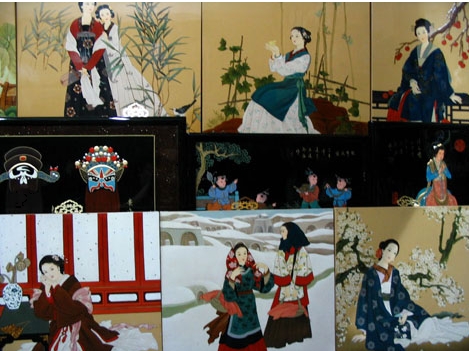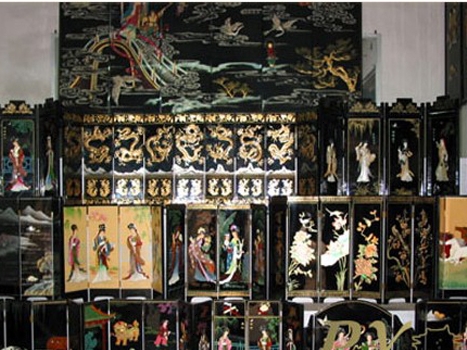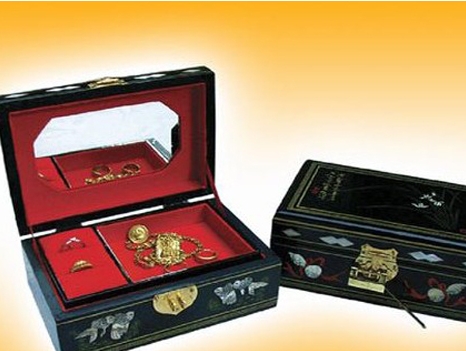
Lacquering and decorating craft for Pingyao buffed lacquer was originated in Pingyao County in the central part of Shanxi Province. It has been spread to northern regions in China. As one of the four famous lacquers in China - gold lacquer in Beijing, bodiless lacquer in Fujian, spotted lacquer in Yangzhou and color-painted lacquer in Pingyao, Pingyao buffed lacquer is famous for the skills of palm buffing, outlining in gold and color painting.
There is a saying going around in the central region of Shanxi Province - "There are three treasures in Pingyao Ancient Town: lacquer, beef and Chinese yam". Lacquer is ranked first among the three treasures. Pingyao Ancient Town is located on the Loess Plateau which was covered with a huge quantity of trees in the Neolithic Age (before 2000 B.C.). A species named "Sumac" was widely spread. Juice of this species was used by the primitive people to daub on utensils to make them shining, handsome and wearable. As lacquer will turn black automatically, it was used to mark literal signs. Pingyao lacquer took shape in the Spring and Autumn Period and had its prime time in the Han Dynasty. Along with the enhancement of the strength of Shanxi merchants, Pingyao lacquer was sold to Mongolia, Russia and Southeast Asia. By the Wei, Jin and Northern and Southern Dynasties, lacquering and decorating craft for Pingyao buffed lacquer had reached high perfection. Lacquers made with the craft had become famous in the world during the Kaiyuan Period of the Tang Dynasty. Buffed lacquer was substantially improved in the Ming and Qing Dynasty because of the emergence and rise of Shanxi merchants.
Pingyao buffed lacquer is famous for numerous complicated procedures. Take ash shaving as an example. Five or six times of shaving are required; the next time of shaving will not commence until the ash shaved up in the previous time gets completely dry. Fascination of Pingyao buffed lacquer can be attributed not only to the exquisite carving, but also to a particular material - Chinese lacquer, a natural lacquer material shedding from sumac after the bark is stripped. Sumac is a species widely spread on the Loess Plateau.

Production of Pingyao buffed lacquer consists of five working procedures: wooden padding, ash padding, painting, drawing and enchasing. After wooden padding for various types of furniture is made with pinewood in wooden padding workshop, the ash padding workshop will be in charge of tangling and swathing wooden padding with dogbane hemp, and daubing it with brick dust mud mixed with pig blood. This procedure is called "Hemp wrapping and ash plastering". The primer is mainly in the color of pitch black, rosiness, apricot and greenish purple, and is drawn with patterns of ethnic style, such as characters in classical novels, dramas, myths and legends. In addition, it may be treated with outlining in gold, color painting, engraving or enchasing, with the effect of fluent lines, harmonious tinge and splendid appearance.

Working procedures in painting workshop are extremely delicate and complicated. "Lacquering" is the most crucial working procedure for each piece of lacquered artwork. Before the painting of ash padding, it is required to wipe the ash padding with emery paper dipped in water and swab it repeatedly by hand in pushing motion until the ash padding is slick. After that, the next round of painting commences, following the aforesaid steps. Five to eight rounds of painting are required to produce a piece of lacquered artwork. Following painting is the procedure of polishing, which is decisive to the quality of each product. The last procedure to make Pingyao buffed lacquer - surface painting - is finished by palm pushing, grinding and polishing. The painting surface should be made mirror-like bright. Rounds of pushing and grinding on painting surface are in direct proportion to its brightness. Accordingly, Pingyao buffed lacquer is suitable for long-term display.





